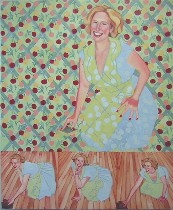 Last time I stopped at Afif Gallery in January, owner Liz Afif-Zane was yearning for company in her neighborhood–more galleries and commerce. Since then, she has gotten a full-time job designing rugs, but she also has gotten a terrific neighbor, Gallery 339, a block and a half away, and business on her block of South Street also is picking up. But she’s got the job, so she’s trying to figure out how to keep the gallery open more hours than at present. But Friday (that’s tomorrow, June 10) is opening night, which means the gallery will be open for business. Otherwise, call her to make an appointment to see this show, which is worth a visit.The main space has a solo exibit by Emily Bicht. Bicht, who lives in New York but has ties to Moore College, where she went to school, mines images of the happy housewife inspired by 1950s advertising. Bicht’s happy housewife reminds me of killer mom Kathy Baker in Boston Public. Amid her sharp knives and ironing boards, inside her patterned dress, there’s a would-be predator. She’s June Cleaver with a cleaver (left top, “Cherries”).
Last time I stopped at Afif Gallery in January, owner Liz Afif-Zane was yearning for company in her neighborhood–more galleries and commerce. Since then, she has gotten a full-time job designing rugs, but she also has gotten a terrific neighbor, Gallery 339, a block and a half away, and business on her block of South Street also is picking up. But she’s got the job, so she’s trying to figure out how to keep the gallery open more hours than at present. But Friday (that’s tomorrow, June 10) is opening night, which means the gallery will be open for business. Otherwise, call her to make an appointment to see this show, which is worth a visit.The main space has a solo exibit by Emily Bicht. Bicht, who lives in New York but has ties to Moore College, where she went to school, mines images of the happy housewife inspired by 1950s advertising. Bicht’s happy housewife reminds me of killer mom Kathy Baker in Boston Public. Amid her sharp knives and ironing boards, inside her patterned dress, there’s a would-be predator. She’s June Cleaver with a cleaver (left top, “Cherries”).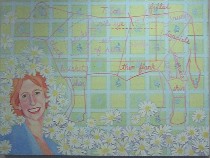 Her forced smile is her parachute and the land she has alit in is wallpaper-patterned so she’s pressed up against the front of the painting in a claustrophobic non-space. Even the floors she’s cleaning are vertical flat patterns. The flowers are camouflage for what is in her heart, which is scheming for survival in this alien world. In some of the paintings, she’s virtually part of the wallpaper, a flat human patterned shape in her patterned dress with her patterned apron (right, “Thin Flank”).
Her forced smile is her parachute and the land she has alit in is wallpaper-patterned so she’s pressed up against the front of the painting in a claustrophobic non-space. Even the floors she’s cleaning are vertical flat patterns. The flowers are camouflage for what is in her heart, which is scheming for survival in this alien world. In some of the paintings, she’s virtually part of the wallpaper, a flat human patterned shape in her patterned dress with her patterned apron (right, “Thin Flank”).The patterns in these paintings are anti-pattern-and-decoration, armed for battle, and intense, made of knives and human hearts mixed with valentine hearts. They have ’50s color schemes and buzzy agitation. One of the wallpaper patters reminds me of some wallpaper my mother picked for the kitchen back in the ’50s. The cherries galore quickly beat her down and irritated her day in and day out for the next 10 years.
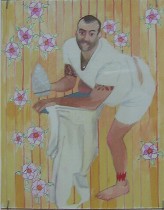 As for the woman, she’s got the exaggerated 50s, sexualized body, and that’s part of the formula for the happy housewife. By the way, she herself is the model for her paper-doll cutie who reappears in all the paintings except in my very favorite piece–perhaps a study for another piece–an image of a modern-day hottie of the male persuasion, tattoos and all, making a sexual move on the ironing board. It was the funniest and freshest piece of all, with a touch of Japanese warrior in the pose(left, “Male Irons”).
As for the woman, she’s got the exaggerated 50s, sexualized body, and that’s part of the formula for the happy housewife. By the way, she herself is the model for her paper-doll cutie who reappears in all the paintings except in my very favorite piece–perhaps a study for another piece–an image of a modern-day hottie of the male persuasion, tattoos and all, making a sexual move on the ironing board. It was the funniest and freshest piece of all, with a touch of Japanese warrior in the pose(left, “Male Irons”). Afif also has a juried group show in the back room, “Hindsight.” The 11 artists drawn from across the county include local artist Ellie Brown. A wonderful painting by John DenHouter, “Homecoming” (right) shows a wheatfield and multiple goal posts sticking up like telephone poles under a vast blue sky. It’s a poem to the endless prairie merely decorated by agriculture and football culture, and the heightened colors suggest mythmaking in storybook land.
Afif also has a juried group show in the back room, “Hindsight.” The 11 artists drawn from across the county include local artist Ellie Brown. A wonderful painting by John DenHouter, “Homecoming” (right) shows a wheatfield and multiple goal posts sticking up like telephone poles under a vast blue sky. It’s a poem to the endless prairie merely decorated by agriculture and football culture, and the heightened colors suggest mythmaking in storybook land.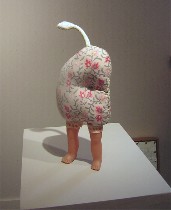 Shannon Robinson’s “Glenda” (left), a hug-object with doll legs as a floral pillow or sofa as a sprouting lima bean as a really scary one-eyed mutant looks nothing like the good witch Glenda from the Wizard of Oz. It seems to come out of the cartoon tradition, a feminine monster in the ToysRUs aisle where girly dolls meet boyish action-figure dolls.
Shannon Robinson’s “Glenda” (left), a hug-object with doll legs as a floral pillow or sofa as a sprouting lima bean as a really scary one-eyed mutant looks nothing like the good witch Glenda from the Wizard of Oz. It seems to come out of the cartoon tradition, a feminine monster in the ToysRUs aisle where girly dolls meet boyish action-figure dolls.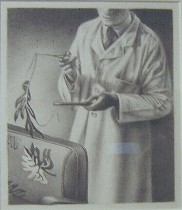 Marilyn Murphy‘s graphite drawings of retro-looking people in surreal, unlikely activities with unlikely Frankenstein equipment also were standouts. Even with noir lighting, the film angles and lab coats, the odd science seems not so much threatening as loopy and ritualistic (right, “Changing Old Patterns”).
Marilyn Murphy‘s graphite drawings of retro-looking people in surreal, unlikely activities with unlikely Frankenstein equipment also were standouts. Even with noir lighting, the film angles and lab coats, the odd science seems not so much threatening as loopy and ritualistic (right, “Changing Old Patterns”).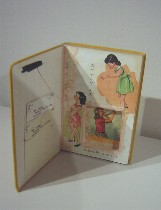 Local artist Brown has added girls and lace and Japanese marks to a retro text book, “Research Ideas for Young Scientists” (left). “I was thinking about how in science Asian women have taken more steps towards progress and leveling the field with men than other ethnicities,” she wrote in an email. The marks, like science, are Greek to most girls–but not to these Japanese school girls whom Brown added. The book, with its retro look, talks to Murphy’s drawings and to Bicht’s work in the front room.By the way, Brown also has work in “Philadelphia Cheek,” the show of young artists opening tomorrow at Seraphin Gallery, and she will be showing work at InLiquid’s Art for Cash Poor art sale Saturday (see post for more info).
Local artist Brown has added girls and lace and Japanese marks to a retro text book, “Research Ideas for Young Scientists” (left). “I was thinking about how in science Asian women have taken more steps towards progress and leveling the field with men than other ethnicities,” she wrote in an email. The marks, like science, are Greek to most girls–but not to these Japanese school girls whom Brown added. The book, with its retro look, talks to Murphy’s drawings and to Bicht’s work in the front room.By the way, Brown also has work in “Philadelphia Cheek,” the show of young artists opening tomorrow at Seraphin Gallery, and she will be showing work at InLiquid’s Art for Cash Poor art sale Saturday (see post for more info).
Almost all the work in this group show interested me. The other artists are
Donna Quinn, John Hyde, Steve D’Angelo, Elizabeth Bisbing, Colleen Toledano, Kay Campbell, and Elaine Ricklin. So if you miss the opening, call and visit.









